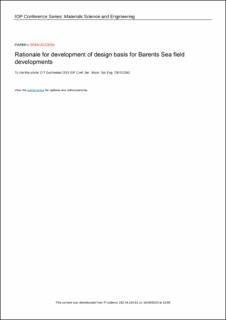| dc.contributor.author | Gudmestad, Ove Tobias | |
| dc.date.accessioned | 2023-01-18T08:30:20Z | |
| dc.date.available | 2023-01-18T08:30:20Z | |
| dc.date.created | 2019-12-05T12:37:07Z | |
| dc.date.issued | 2019 | |
| dc.identifier.citation | Gudmestad, O. T. (2019). Rationale for development of design basis for Barents Sea field developments. In IOP Conference Series: Materials Science and Engineering (Vol. 700, No. 1, p. 012042). IOP Publishing. | en_US |
| dc.identifier.issn | 1757-8981 | |
| dc.identifier.uri | https://hdl.handle.net/11250/3044179 | |
| dc.description.abstract | Developments of hydrocarbon fields in the Barents Sea would normally include surface process units; thus, we must take into account the ice conditions in the area. Alternatively, smaller fields can be developed as satellites to existing production units. Full well stream to shore facilities may also be considered, in the case that one can document the flow conditions in the pipeline(s). Although glacial ice historically has been present all over the Barents Sea, the probability of meeting glacial ice in the southern part is very low, regarded by many as "negligible". At which latitude one could expect sea and glacial ice in the future is, however, uncertain, as past experience has seen glacial ice on the Coast of Finnmark County and there are ongoing processes related to global warming which might increase the probability of iceberg encounter at the location. We will discuss concerns related to the selection of the design basis for the Barents Sea, including the Russian part of the Barents Sea, and discuss the term "negligible". Of particular interest are criteria for the need for disconnection options for production units. The paper concludes with recommendations for thorough preparation of the design basis for the entire Barents Sea area. | en_US |
| dc.language.iso | eng | en_US |
| dc.publisher | IOP Publishing | en_US |
| dc.rights | Navngivelse 4.0 Internasjonal | * |
| dc.rights.uri | http://creativecommons.org/licenses/by/4.0/deed.no | * |
| dc.title | Rationale for Development of Design Basis for Barents Sea field developments | en_US |
| dc.type | Peer reviewed | en_US |
| dc.type | Journal article | en_US |
| dc.description.version | publishedVersion | en_US |
| dc.rights.holder | The authors | en_US |
| dc.subject.nsi | VDP::Teknologi: 500 | en_US |
| dc.source.pagenumber | 7 | en_US |
| dc.source.volume | 700 | en_US |
| dc.source.journal | IOP Conference Series: Materials Science and Engineering | en_US |
| dc.source.issue | 1 | en_US |
| dc.identifier.doi | 10.1088/1757-899X/700/1/012042 | |
| dc.identifier.cristin | 1757110 | |
| cristin.ispublished | true | |
| cristin.fulltext | postprint | |
| cristin.qualitycode | 1 | |

